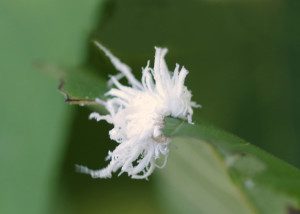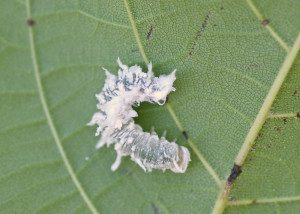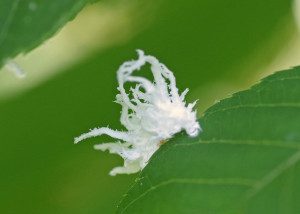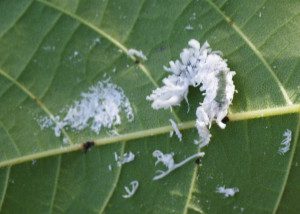Howdy, BugFans,
Wooly – one “l” or two, take your pick.
The BugLady keeps running into herself on-line as she does research, which is scary – makes her think that she ought to know what she’s talking about. Lots of BOTW pictures are also floating around in Google Images, which results in a steady trickle of correspondence both national and international (the BugLady cheerfully told the folks at a Field Station in India that solving their problem of small aquatic worms and other invertebrates in their tap water was way beyond her pay grade).
When she got a query recently about the identity of a three-quarter-inch “worm” that had feathery tufts and hung out on the bottom sides of leaves, it didn’t ring any bells. Wooly alder and wooly beech aphids cover themselves with waxy filaments, and so do the nymphs of some planthoppers (and she had photographed what she thought was a feathery planthopper on her own walnuts last year), but worms? Anyway, two weeks later, she was staring at some of these mystery worms in person.
It was fun reading accounts in which other authors experienced similar confusion, several describing the joys of Googling “fuzzy white worm,” and other descriptors. The BugLady, who is “key-word-challenged,” feels their pain. Then she looked more closely at a larva and suspected that it might be a sawfly, and Google became more accommodating. It’s a Butternut woolyworm (Eriocampa juglandis). And yes – her “planthopper” was a BWW.
Sawflies – sometimes called “wood wasps,” a common name they share with a few other primitive wasps – are harmless members of the wasp order, Hymenoptera. The females’ toothed ovipositor gives them their name. Sawflies lack the “wasp waist” of other Hymenopterans, and although their larvae are often mistaken for caterpillars, the legs are different. Sawfly larvae are fussy eaters, with many species tied to just a few host plants, and some larvae are considered pests. One source said that many of the plants that sawflies prefer are chemically defended, which seems to bother the sawflies not at all. Larval defense strategies include communal feeding (potential predators have trouble figuring out where one larva stops and the next one starts) and spitting vile liquids from their mouths.
When BWWs, which are in the Common sawfly family Tenthredinidae, are found south of the Mason-Dixon Line, it’s mainly in connection with black walnut trees, but the bulk of their range is the northeastern quadrant of North America – not coincidentally, the range of the butternut tree.
There’s some modern literature about BWWs, but, as always, the BugLady is charmed by the scientific writing of one-hundred-plus years ago. Insects Injurious to Forest and Shade Trees (1881) describes them as “cylindrical, with eight pairs of soft, fleshy abdominal legs; the sections are transversely wrinkled pale, pea-green, with a powdery secretion low down on the sides, but above and on the back arise long flattened masses of flocculent matter (exactly resembling that produced by the wooly plant lice and other homopterous insects), forming an irregular dense cottony mass reaching to a height equaling two-thirds the length of the worm and concealing the head and tail.” It goes on to say that the adults, at about ¼” long http://bugguide.net/node/view/754965/bgimage, are “seemingly small for so large larvae.” It is believed that their disguise protects them from predators.
The BWW has a low-key presence in University/Cooperative Extension literature/Wanted Posters. Its populations can vary drastically from year to year, and it appears in mid-summer (in the North) when its host is fully leafed out, which lessens its impact. Trees survive with some temporary cosmetic damage, and control is generally not needed. Females saw into the mid-rib of leaflets and deposit 20 to 30 eggs, one at a time, which eventually causes the leaflet to droop or fold and the midrib to turn pale; and while small larvae chew random holes in leaves, larger one may finish them off entirely, leaving bits of the larger veins behind.
Unadorned larvae http://bugguide.net/node/view/79473/bgimage hatch in about a week and commence producing waxy, white fronds to adorn themselves. Each molt leaves the feathery skin behind http://bugguide.net/node/view/330789/bgimage, and the larva must cloak itself anew. Finished growing, they drop to the soil. The pre-pupal larva forms a cocoon in which it overwinters in a state of suspended animation (aestivation), pupating in spring. The cycle is completed when adults emerge in early summer (here in God’s Country).
Enjoy BWW explorations (and pictures) by the folks at Hilton Pond at http://www.hiltonpond.org/thisweek030708.html.
Kate Redmond, The BugLady
Bug of the Week archives:
http://www4.uwm.edu/




